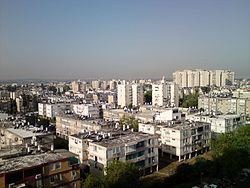Name meaning Judah's Light Local time Sunday 5:13 AM | Founded 1949 Area 5 km² Team F.C. Ironi Or Yehuda | |
 | ||
Weather 12°C, Wind SE at 8 km/h, 77% Humidity University Center for Academic Studies | ||
Or Yehuda (Hebrew: אוֹר יְהוּדָה, Arabic: أور یهودا) is a city in the Tel Aviv District of Israel. In 2015 it had a population of 36,164.
Contents
- Map of Or Yehuda Israel
- Bronze Age through Roman period
- Byzantine period
- Ottoman period
- British Mandate period
- 1948 and after
- Or Yehuda and Ramat Pinkas
- Demographics
- Economy
- Education
- Twin towns Sister cities
- References
Map of Or Yehuda, Israel
Bronze Age through Roman period
Or Yehuda is located on the site of the biblical town of Ono. A bit confusingly, the name of biblical Ono was wrongly inherited by another modern town located not far from Or Yehuda, namely Kiryat Ono.
Both the Canaanites and Israelites referred to the town as Ono (1 Chronicles 8:12), which name continued all throughout the First and Second Temple periods.
Byzantine period
Jewish classical writings mention the city as being formerly enclosed by a wall. Kafr 'Ana was known as Onous in the Byzantine period.
Ottoman period
During early Ottoman rule in Palestine, the revenues of the village of Kafr 'Ana were in 1557 designated for the new waqf of Hasseki Sultan Imaret in Jerusalem, established by Hasseki Hurrem Sultan (Roxelana), the wife of Suleiman the Magnificent. In 1596, Kafr 'Ana was a village in the nahiya ("subdistrict") of Jerusalem ( liwa' ("district") of Jerusalem), with a population of 116. Villagers paid taxes to the authorities for the crops that they cultivated, which included wheat, barley, olives, and fruit, as well as on other types of property, such as goats and beehives and vineyards.
In 1596, Saqiya was a village in the nahiya of Ramla (liwa´ of Gaza), with a population of 270. It paid taxes on a number of crops, including wheat, barley, fruit and sesame, as well as on other types of property, such as goats, beehives and vineyards.
The Syrian Sufi traveller al-Bakri al-Siddiqi, who toured the region in the mid-eighteenth century, wrote that he passed through Saqiya while he was on his way to Jaffa.
French explorer Victor Guérin visited Kafr 'Ana in 1863 and noted that "near the village are two shallow basins hollowed in rock, not built up, which receive the winter rains. Several wells are here as well, which permit the gardens to be irrigated. By the side of one of these wells I observed trunks of columns which seemed ancient." In 1882, the Palestine Exploration Fund's Survey of Western Palestine described Kafr 'Ana as a village built of adobe bricks and surrounded by palm trees.
British Mandate period
In the 1922 census of Palestine conducted by the British Mandate authorities, "Kufr Ana" had a population of 1,374, all Muslims, while "Sakieh" had a population of 427, also all Muslims.
1948 and after
The villages of Kafr 'Ana, Saqiya and Khayriya were depopulated in the weeks leading up to the 1948 Arab–Israeli War, during the Haganah's offensive Mivtza Hametz (Operation Hametz) 28–30 April 1948. Local Arabs also report of military events that preceded by a few days Operation Hametz.
Or Yehuda and Ramat Pinkas
The modern town of Or Yehuda was established in 1950 on the lands of Saqiya and Kafr 'Ana by Jews from Iraq and North Africa. Ramat Pinkas was established in the year 1952, on land formerly belonging to Khayriya.
In 1988, Or Yehuda was declared a city.
On April 2001, Hamas suicide bombers blew up a car in Or Yehuda, injuring eight people.
In 2008, part of the Ef'al Regional Council, including Ramat Pinkas, merged into Or Yehuda.
Demographics
According to the CBS, in 2001 the ethnic makeup of the city was 100.0% Jewish. In 2001 there were 13,900 males and 14,000 females. The population of the city was spread out with 34.6% 19 years of age or younger, 17.7% between 20 and 29, 20.5% between 30 and 44, 15.8% from 45 to 59, 3.1% from 60 to 64, and 8.2% 65 years of age or older. The population growth rate in 2001 was 3.4%.
Economy
Babylon Ltd., a developer of online translation programs that holds the Guinness World Record for the highest number of downloads of a language solution software, is based in Or Yehuda.
Education
In 2000, Or Yehuda had 14 schools and a student enrollment of 5,147 students (10 elementary schools with 2,894 students, and 6 high schools with 2,253 students). 55.7% of 12th graders were entitled to a matriculation certificate in 2001.
In 1982, Or Yehuda was one of the first few cities to take part in the Program for Talented Youth in Mathematics, established by Professor Zvi Arad and Bernark Pinchuk, at Bar-Ilan University. Among the high-school students of Or Yehuda participating in this program was Boaz Tsaban, who proceeded to win national prizes for his achievements, and is now a Professor of mathematics at Bar-Ilan University. Since the establishment of this program, a good number of high-school students took part in this program.
In 1996, the city's mayor Yitzhak Bokovza barred 50 children of Ethiopian Jewish families (Beta Israel) from registering in local schools.
Twin towns — Sister cities
Or Yehuda is twinned with:
